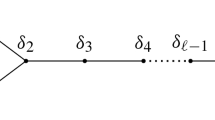Abstract
It is proved that the wreath product of a second-order group and the commutant of a dihedral group is imbedded into a multiplicative group of a modular group algebra of a dihedral group of order 2n. This implies that the nilpotency class of the multiplicative group is equal to 2n−2, i.e., to the order of the commutant of the dihedral group.
Similar content being viewed by others
References
A. Shalev, On some conjectures concerning units inp-group algebras. Proceedings of the Second International Group Theory Conference (Bressanone, 1989),”Rend. Circ. Mat. Palermo, No. 23, 279–288 (1990).
J. T. Buckley, “Polynomial functions and wreath products”Ill. J. Math., No. 14, 274–282 (1970).
A. Shalev, “The nilpotency class of the unit group of a modular group algebra. I,”Isr. J. Math.,70, No. 3, 257–266 (1990).
A. Shalev, “Dimension subgroups, nilpotency indices, and the number of generators of ideals inp-group algebras,”J. Algebra, No. 129, 412–438 (1990).
R. K. Sharma and V. Bist, “A note on Lie nilpotent group rings,”Bull. Austral. Math. Soc.,45, No. 3, 503–506 (1992).
A. Sandling, “Presentations for the unit group of modular group algebras of groups of order 16,”Math. Comp.,59, No. 200, 689–701 (1992).
A. Shalev, “Lie dimension subgroups, Lie nilpotency indices, and the exponent of the group of normalized units,”J. London Math. Soc.,2, No. 43, 23–36 (1991).
A. K. Bhandari and I. B. S. Passi, “Lie nilpotency indices of group algebras,”Bull. London. Math. Soc.,24, No. 1, 68–70 (1992).
A. Shalev, “The nilpotency class of the unit group of a modular group algebra, III,”Arch. Math. (Basel), No. 60, 136–145 (1993).
X. Du, “The centers of radical rings,”Can. Math. Bull., No. 35, 174–179 (1992).
Author information
Authors and Affiliations
Additional information
Translated from Ukrainskii Matematicheskii Zhurnal, Vol. 47, No. 1, pp. 39–45, January, 1995.
Rights and permissions
About this article
Cite this article
Konovalov, A.B. On the nilpotency class of a multiplicative group of a modular group algebra of a dihedral 2-group. Ukr Math J 47, 42–49 (1995). https://doi.org/10.1007/BF01058794
Received:
Issue Date:
DOI: https://doi.org/10.1007/BF01058794



